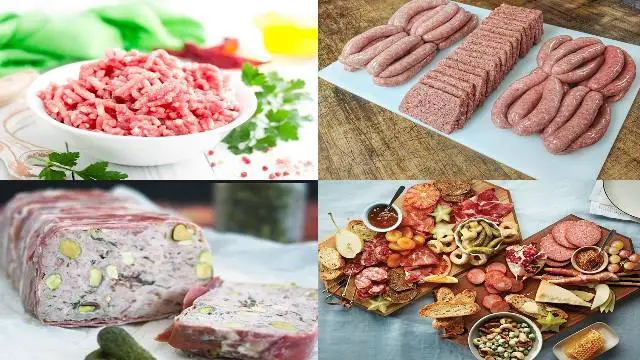FORCEMEATS
The term Forcemeat or farce, is used to describe the basic mixture that needs to be prepared in order to produce charcuterie products.
The word farce comes from the Latin farcire. A farce or forcemeat is a ground seasoned mixture of meat, game, poultry, fish or vegetables, prepared as a dish on its own or used to stuff other numerous other items such as eggs, meat, fish and poultry, pastry shells and perhaps even pasta. Such dishes are prepared in the Garde Manger.
Forcemeats are used in the preparation of a various cold dishes such as pate, terrines, galantines, ballotines, quenelle, roulade, mousse and mousseline.
Pate: from the old French paste, meaning paste.
Terrine: from the Latin Terra, meaning earth.
Galantine: from the old French galant, meaning gorgeous or showy
Also from the old French term galine, meaning chicken.
Ballotine: from the Italian Balla, meaning ball.
Quenelle: from the Alcascian French knodel, meaning dumpling
Roulade: from the French rouler, meaning to roll
Mousse/Mousseline: from the French, meaning froth.
Timbale: from the English Thimble
COMPOSITION OF THE FORCMEAT
Traditional forcemeat /farce is made up of four parts:
- The Meat (Primary Ingredient)
- The Binder
- Seasoning, Flavoring and Garnish
- The Additives
The Meat :
Consists of three elements:
– The Dominant Meat (basic meat) which could include veal, game, poultry, rabbit, duck, or even fish. This will provide the dominant flavor and will also name the dish. e.g. chicken liver in a Chicken Liver Pate. These ingredients should be fresh and of prime quality. All bones, skin, sinews and gristle must be removed and the flesh cut up into ½” pieces for grinding. The dominant meat normally accounts for 40% of the meat component.
- Lean Pork which contributes to the bulk as well as the flavor. This will be about 30% of the meat component. Nowadays, when preparing forcemeat using other varieties of meat, the lean pork an be substituted with another subsidiary meat. For example, in a Lobster Mousse, the lean pork will be substituted with shrimp or some other cheap white fish. The important thing to remember is that the subsidiary meat should complement the dominant meat
- Pork fat which gives richness and smoothness to the product as well as for its binding qualities. This too will be 30% of the meat component. Again, other fats such as butter and cream can be substituted in order that the meat and fat compliment each other. In the Lobster mousse, cream would be better suited as a fat instead of pork fat.
A. TYPES OF FORCEMEATS :
There are many types of forcemeats, farces and stuffings .They are used in variety of ways for making quenelles mousses mousselins, pates, galantines, for stuffing breast of lamb or veal , poultry , game, fish, vegetables and eggs. Forcemeats are made of meat , poultry and close grained fish , finely ground or pureed and mixed with
seasonings.
1. Fine Forcemeats for Quenelles
2. For Galantines
3. Mousseline Forcemeat
4. For Pates
5. Fish
6. Quenelles Forcemeats with Panada.



